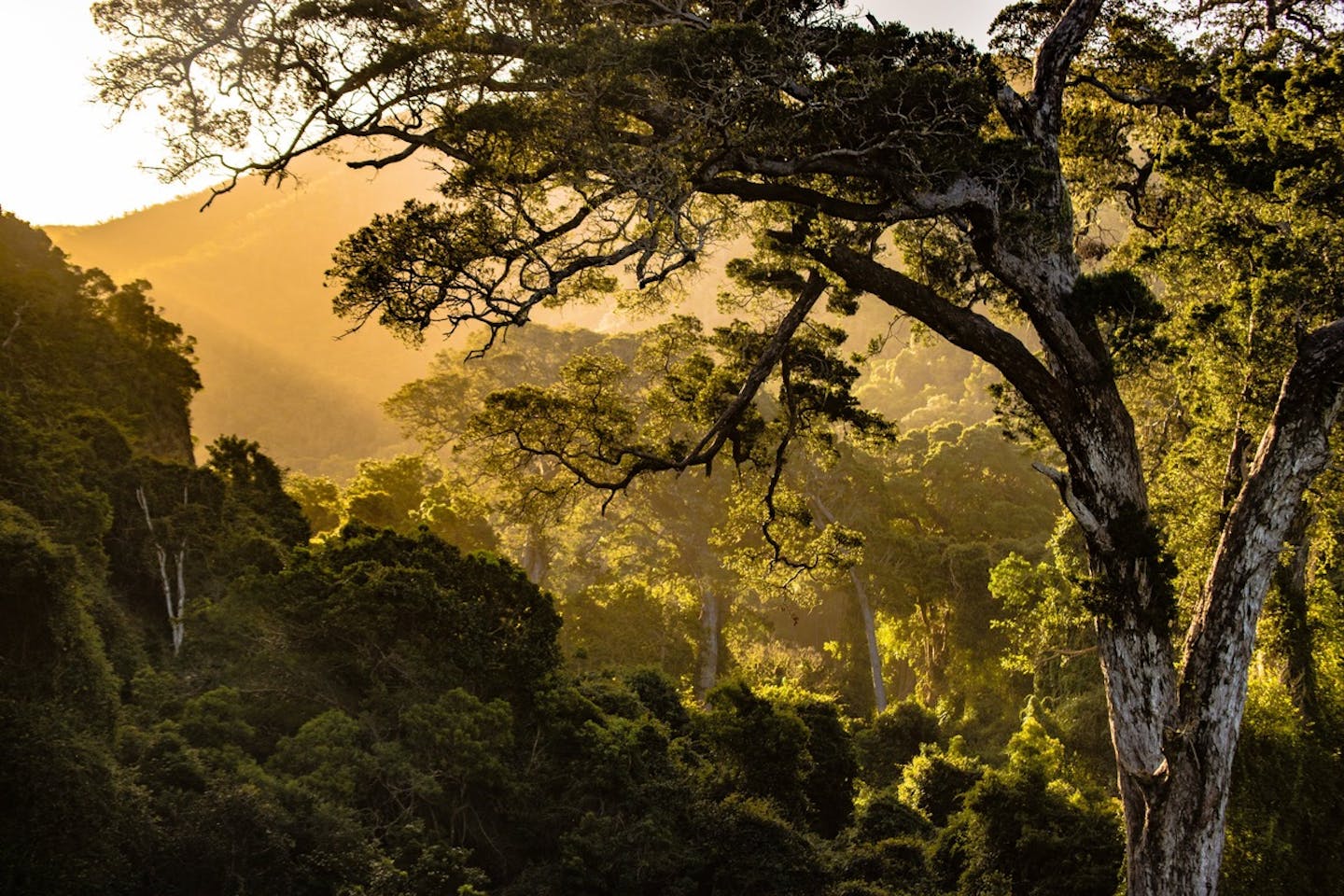The Global Deal For Nature
Opportunities to address both climate change and the extinction crisis are time-bound. It has become clear that beyond 1.5°C average rise in global temperature, the biology of the planet becomes gravely threatened as ecosystems literally begin to unravel. Similarly, if current land conversion rates, poaching of large animals, and other threats are not dramatically slowed or halted in the next ten years, a ‘point of no return’ could be reached for multiple ecosystems and species.
While there are several proposed pathways to mitigating climate change, including uncertain technologies that could remove carbon from the air, we know that natural ecosystems are key to maintaining the abundance and diversity of life on Earth as well as human prosperity in a warming world.
Carbon-rich ecosystems, by definition, sequester (both store and pump) the most carbon from the atmosphere. This carbon sequestration service is key to climate stabilization and to climate change mitigation. It is no coincidence that some of the most carbon-rich ecosystems on land—natural forests—also harbor high levels of biodiversity.
Evolution has generated carbon-rich forests by packing in long-lived trees that also feed stable soil carbon storage pools. This effect is made possible by high levels of co-existence among diverse species and growth forms, and this co-existence has been made possible by the biotic interactions that generate competition and defense.
Try to imagine a tropical forest without pests, pathogens, pollinators, decomposers, or predators. You likely can’t. That’s because their interactions with primary producers (the plants) are what generate the carbon-rich growth forms that take the carbon out of the atmosphere and store it in the soil and woody biomass. In the words of the Heinz Award-winning climate and biodiversity scientist and co-author of the GDN, Greg Asner,
These carbon sequestration and storage benefits extend far beyond tropical rainforests into other biomes—peatlands, tundra, mangroves, ancient grasslands, wetlands, and the marine realm. All of these ecosystems conserve distinct assemblages of plants and animals and have a role to play in balancing the global climate system.

New of rainforest in Borneo using aerial spectroscopy. Image by Greg Asner and Nick Vaughn, ASU Center for Global Discovery and Conservation Science.
It is based on this co-dependence of biodiversity and climate mitigation that the paper A Global Deal for Nature (GDN): Guiding Principles, Milestones, and Targets proposes a bold vision for what we need to do to ensure the functioning of the biosphere, especially as the world is stressed from increased global temperatures.
The GDN is based on scientific guidelines that could interlink two different United Nations conventions—the Framework Convention on Climate Change (aka the Paris Agreement) and the Convention on Biological Diversity—making them mutually reinforcing.
We emphasize three themes that, taken together, can save life on Earth: mitigating climate change, protecting biodiversity, and reducing threats to ecosystem intactness and species survival.
First, the paper makes a strong connection between climate change and biodiversity loss. Recent literature, compiled in the new book Biodiversity and Climate Change (Lovejoy & Hannah, ed.), shows that anything above 1.5°C in global average temperature rise would mean the loss of species on such a scale as to be potentially irreversible. Thus, if we aren’t able to solve the climate crisis, we will not be able to solve the biodiversity crisis.
Conversely, if we aren’t able to cease the destruction of forests and other habitats, we will likely be unable to stay below the threshold of 1.5˚C. Here’s why…
Approximately half of Earth’s terrestrial surface is currently in a natural condition and capable of supporting functioning ecosystems. A new climate model published by Springer Nature in early 2019, Achieving the Paris Climate Agreement Goals, shows that we can only meet the target of remaining below 1.5°C in average global temperature rise by ending the conversion of forests and other natural lands by 2030, effectively placing half of the Earth’s lands under protection.
This major conservation effort would need to be coupled with a forest restoration effort and other natural climate solutions to draw down carbon from the atmosphere (providing ‘negative emissions’) alongside a rapid transition to carbon-free energy, like wind and solar power, by 2050 (see Fig 1).
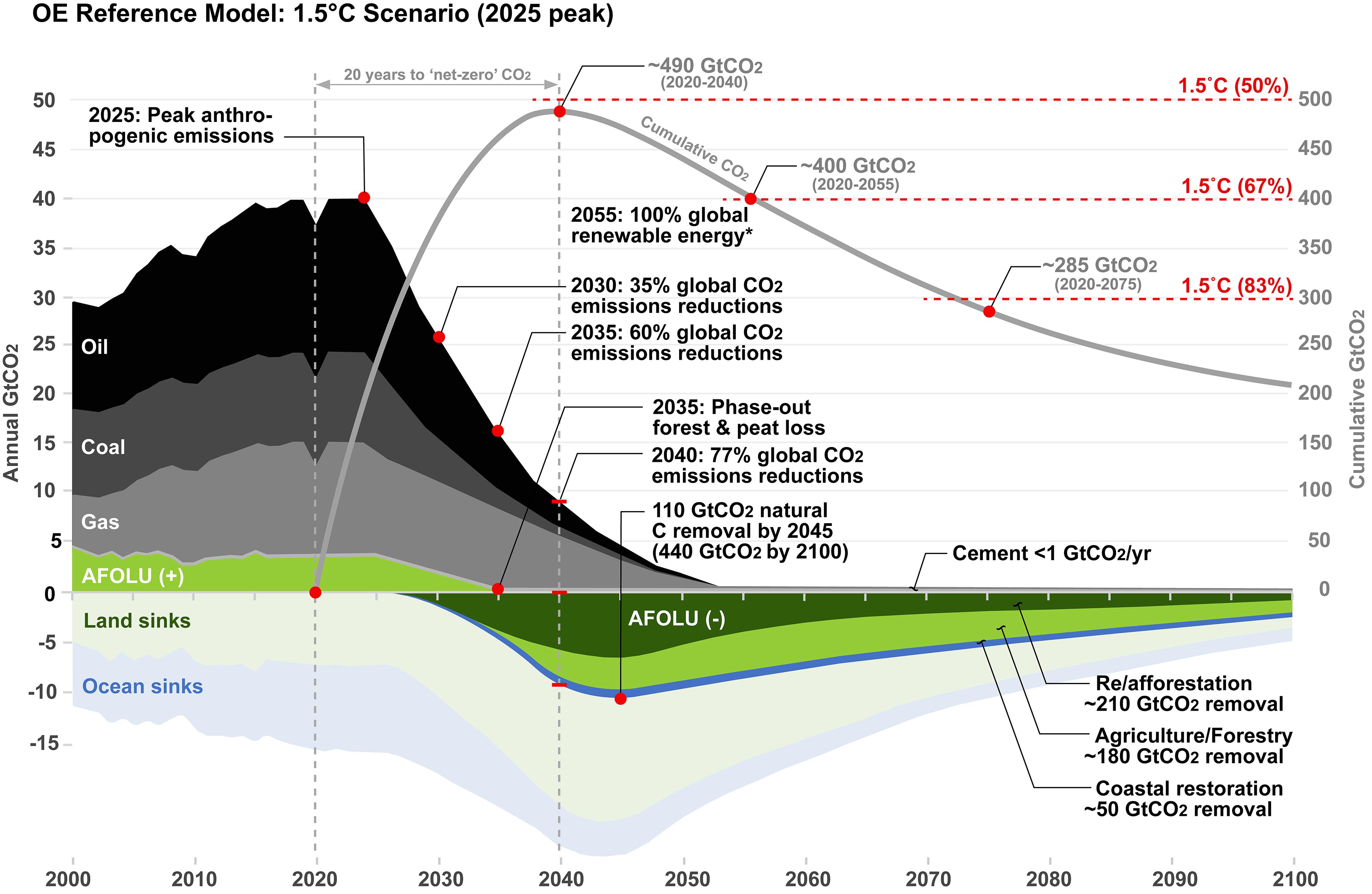
The One Earth Reference Model, updated in 2022, limits global average temperature to 1.55°C above early industrial levels (c.1850-1900) with a peak in cumulative anthropogenic emissions of approximately 500 GtCO2 in 2045 (above 2020 levels). This is achieved by (1) a rapid reduction in fossil fuel emissions (black) with approximately 50% of projected energy demand met through renewables by 2035 and 100% renewable energy across all sectors by 2055*; (2) a full phaseout of deforestation and peat loss by 2035 with ongoing net-zero emissions from all other land uses (such as agriculture and forestry); and (3) approximately 110 GtCO2 of carbon removal by 2045 and 450 GtCO2 by 2100 from 11 ecosystem restoration pathways (green and blue). The model relies upon a rapid reduction of both methane and nitrous oxide emissions by 2040 -- one-half and one-third respectively. *100RE excludes direct emissions from cement production and some industrial processes, totaling < 1 GtCO2/yr. The greenhouse gas scenario was run with MAGICC7, a prime reduced-complexity model to determine radiative forcing and projected global temperature rise, based on IMAGE quantification of the SSP1-Baseline scenario in the IPCC SR1.5 database. The model projects that natural land carbon sinks (light green) and ocean carbon sinks (light blue) continue to function through 2100, but decline in the second half of the century. The energy decarbonization scenario is optimized for 72 sub-regions modeled in hourly increments with a final emissions peak in 2025. The results are in alignment with the carbon budgets documented in IPCC’s Sixth Assessment Report (WGI, 2022) -- 500 GtCO2 for a fair chance (50%); 400 GtCO2from 2020 for a good chance (67%); and 300 GtCO2for a near certainty (83%) of limiting warming to 1.5°C. Note: The temporary drop in fossil fuel emissions due to the COVID-19 pandemic appears to occur before 2020 in the scenario timeline. This is due to the standard practice of plotting average annual emissions, rather than monthly emissions, and does not affect the final results.
How does this translate to conservation targets? The GDN aims to highlight a new era of ambitious conservation in which international institutions, governments, and people are working together to save nature—from supporting communal conservancies in Namibia’s Damaraland refuge for lions and elephants to Indigenous communities in the Peruvian Amazon that conserve key ecosystems and safe havens for jaguars and rare primates to the last home of the orangutan in indigenous reserves in Borneo, as well as incentives for governments to legally protect intact boreal forests across Canada, Russia, and northern Europe that are home to so many breeding songbird populations.
Because protection will be phased in over time, and because life on Earth is distributed unevenly, it’s crucial that biologically important areas are protected first and that protection is done in a representative matter. The paper demonstrates how expanding PAs to meet the 30% by 2030 milestone could improve representation and the terrestrial areas of the Earth that have already met this target.
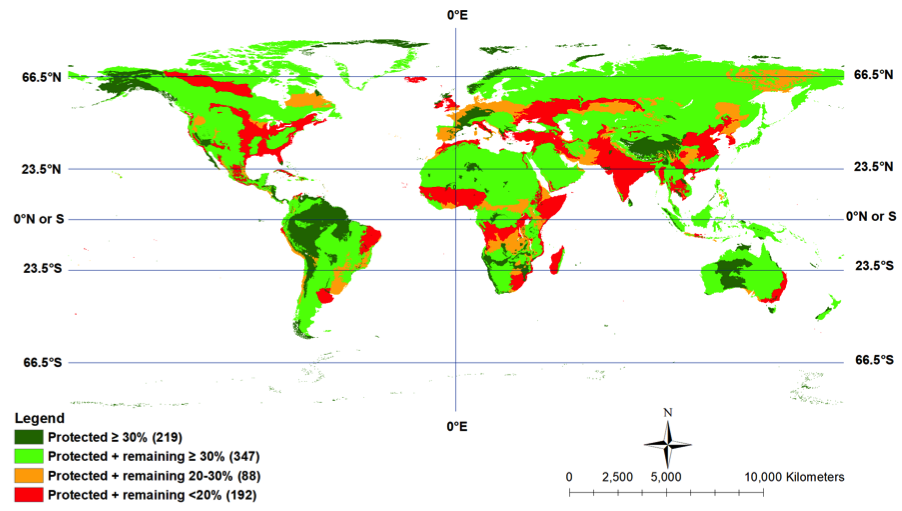
Fig 2. Level of protection of the world’s terrestrial ecoregions. The assessment shows ecoregions that have more than 30% protected already (dark green); those that have enough habitat remaining to achieve 30% or more with designation only (light green); and those regions that would require some (orange) or significant amounts of restoration (red). Note that the areas in red have an average amount of only 6% remaining habitat. Meeting a target of 10% would be a significant achievement for many of these regions.
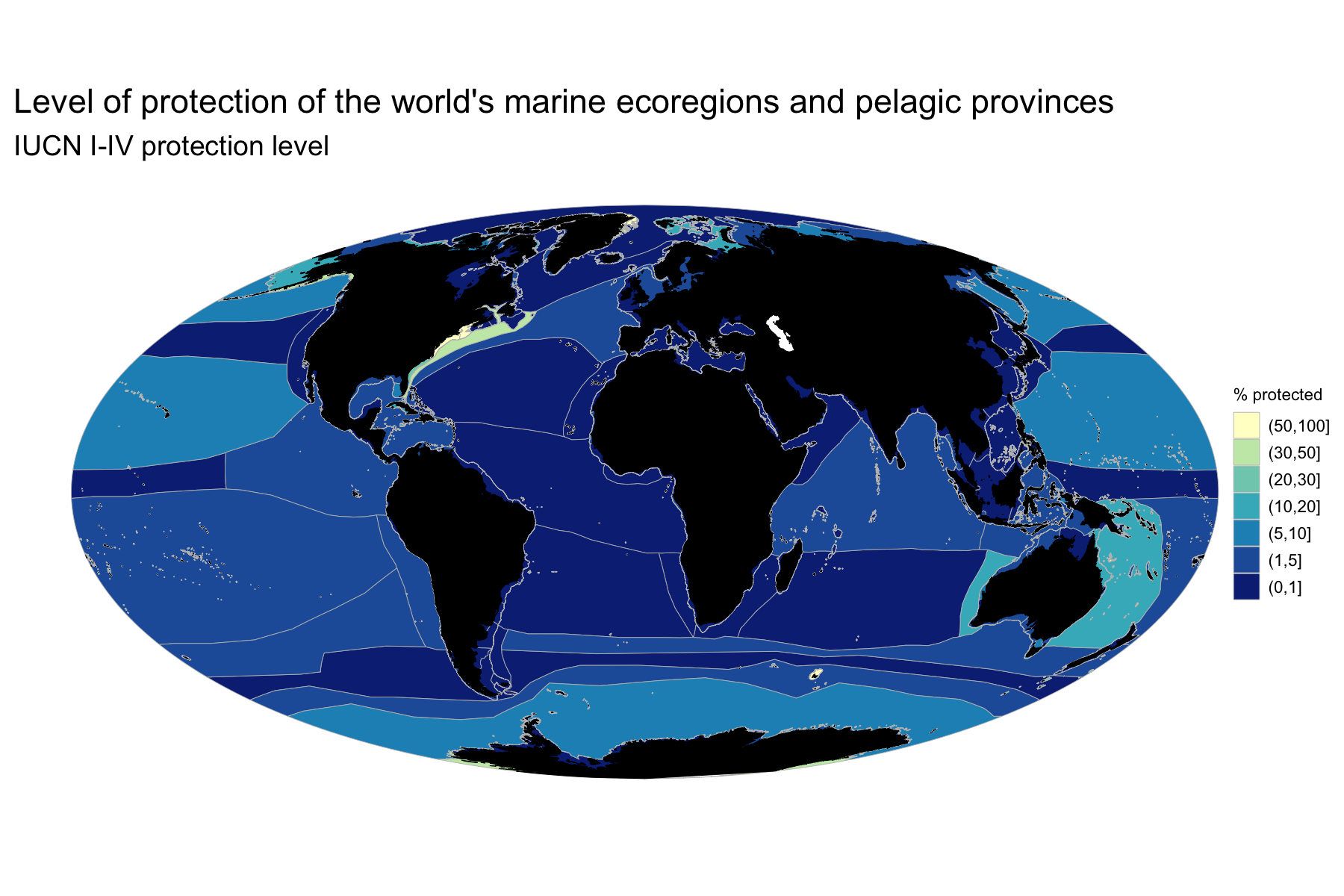
Fig 3. Protection levels of the world's marine ecoregions. This assessment highlights the current shortfalls in ocean protection by showing that the vast majority of the marine ecoregions have protection levels well below the 10% Aichi target. Of the total 269 coastal and pelagic ecoregions, only 41 - representing 6% of the ocean - have met the Aichi target, and 151 - representing 57% of ocean - have less than 1% of their area under protection.
Besides representation, the paper highlights groups of high-priority natural sites and species that should be targeted within ecoregions. Milestone of a GDN implemented by 2030 would include protecting all 600 sites containing the world’s last homes of endangered species per Alliance for Zero Extinction Sites (AZEs), 90% of Key Biodiversity Areas (KBAs), 80% of extant primary habitats from 2018 baseline, and doubling of at least 10 key populations of the world’s megafauna (see below table for examples of proposed features). Protecting areas with key populations of extant large mammals can also help protect the world’s terrestrial carbon storehouses:

While there are clearly many ways to get to the goal of protecting half the Earth, the GDN paper champions a pathway that prioritizes the representation of biodiversity for vertebrates, invertebrates, and plant species. Many analyses show how an extinction crisis can be averted by protecting the most important sites between now and 2030 as part of the 30% protected target, focusing not just on large, intact areas, but also small habitat patches that are essential for the survival of species, as well as the provisioning of ecosystem services such as pollination. A first-ever analysis of the overlaps between many different conservation priorities was published in the paper (see Fig 4):
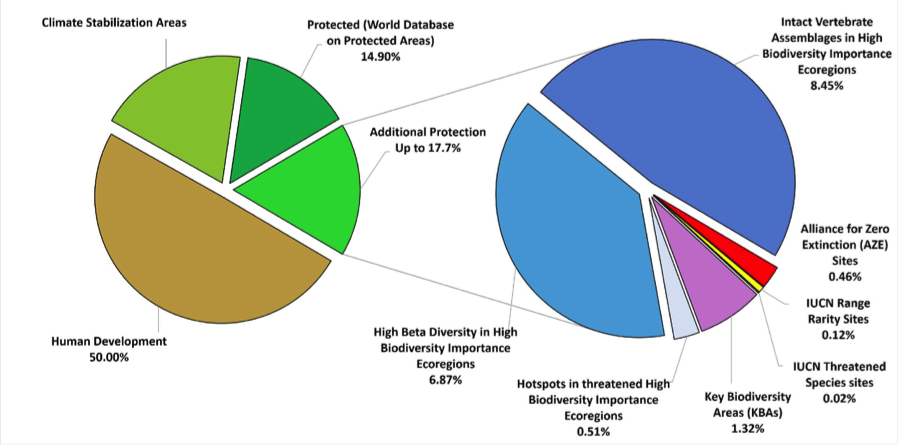
Fig 4. Increasing representation of important terrestrial and freshwater biodiversity sites for global 2030 milestones. Adding together the unique contributions of 7 sets of conservation priorities totals (right) approximately 17.7% of additional land recommended for the 2030 milestone. Approximately 20% in additional land (left) could be established as Climate Stabilization Areas in the near-term.
For the marine realm, the GDN calls for closing enormous gaps in marine conservation: studies show that 35-50% of the ocean must be protected to meet biodiversity protection and sustainability goals, yet only 2% of the world’s ocean is currently in fully to high protected marine reserves. Our recommendations for expanding this system include both addressing representation, but also providing full protection of all critical habitats for threatened species, as well as critical migratory corridors for endangered species of fish, marine mammals, and sea turtles (see Fig 5).

Fig 5. Increasing representation of important marine biodiversity sites for global 2030 milestones. Adding together the unique contributions of 4 sets of conservation priorities totals (right) approximately 22.6% of additional marine areas recommended for the 2030 milestone. Approximately 20% in additional marine areas (left) could be established as Other Effective Conservation Areas (OECMs) in addition to pending and proposed MPAs.
The success of a GDN will depend not only on expanded area-based protection measures but also on ensuring policies are in place to reduce threats and drivers of habitat and species loss. Moving agricultural expansion to degraded areas; careful oversight and planning to avoid harmful impacts of transportation expansion projects; and banning the international transport for commercial purposes of all threatened wildlife and plant species should be in place by 2050.
Support will be needed to enable titling and management of indigenous lands as part of the global reserve system, to national governments seeking to protect intact habitats under climate stabilization areas, and to identify, conserve, and protect fragments of habitat that may be embedded in working landscapes – yet are essential to ecosystem services and biodiversity conservation.
Earth’s bounty underpins human well-being, and yet we are poised to wipe these out in the blink of an eye in geological time. Now it is time to give back before our living standards and spirits are further diminished by the loss of the diversity around us. With recent advances in technology and globally available earth information systems, we have the tools necessary to protect most of life on Earth and monitor our progress, should we organize and choose to do so.
Creating a Global Deal for Nature would allow humanity to develop a vibrant low-impact economy while leaving room for the rest of life on Earth, becoming the overarching conservation paradigm for this century. Together, the Global Deal for Nature and the Paris Climate Agreement will foster nature and humanity’s health and a future for all species and future generations.
Sign the Global Deal for Nature petition